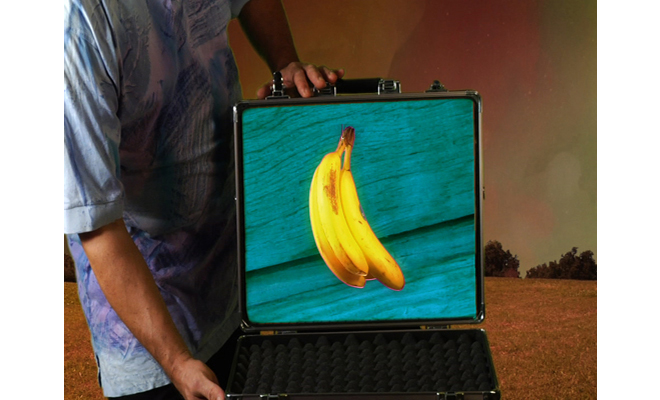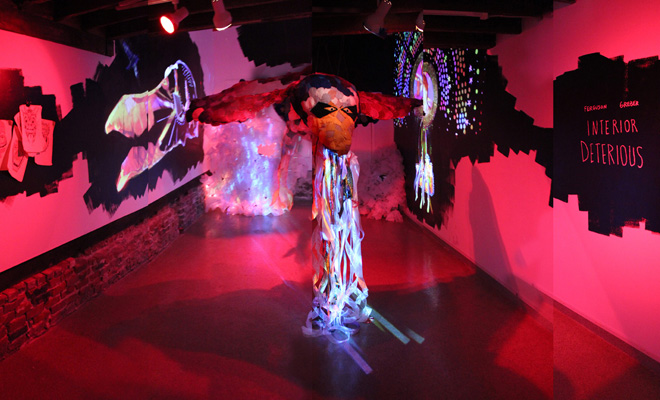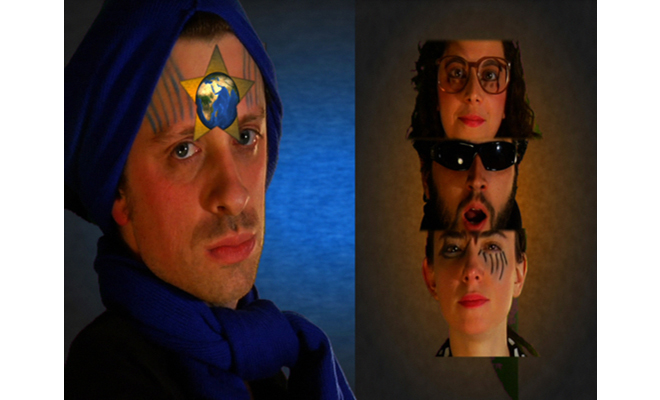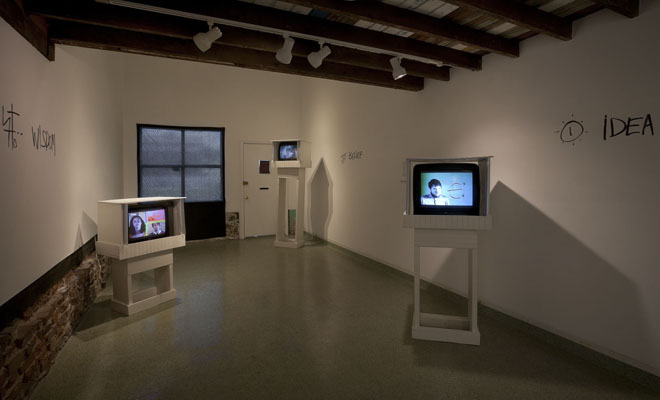A Pumpkin Pencil for the Soul: The Video Art of Dave Greber

Dave Greber, The Fool, The Devil, The Hierophant and the Wheel, 2010. Four-channel video installation (still from The Wheel). Courtesy the artist.
1996 was a banner year for video art. Matthew Barney won the Hugo Boss Prize for his work on the first two Cremaster Cycle films. Douglas Gordon won the Turner Prize (a first for a video artist) in part on the merits of his film 24 Hour Psycho. Pipilotti Rist wowed the art world with her loopy yet sultry video Sip My Ocean, and Bill Viola debuted the haunting videos The Crossing and The Messenger. An exhibition devoted to the “Father of Video Art,” Nam June Paik, who presciently coined the term “Electronic Super Highway,” continued its journey to museums across the country. Outside the world of fine art, a revolution was stirring in commercial cinema as independent films such as Danny Boyle’s Trainspotting shook the masses with its unconventionally visceral perspective. Mike Judge brought America’s favorite idiot savants, Beavis and Butt-Head, and their brand of ultra-low-brow humor and societal critique to the big screen in Beavis and Butt-Head Do America, and if that wasn’t enough, the first infomercial for the George Foreman Grill exploded across the nation’s late-night airwaves.
In the midst of all this electronic media magic, in a kitschy wood-paneled den somewhere in suburban Philadelphia, one of New Orleans’ most celebrated young video artists was “born” by way of a terribly bad but hilariously goofy home video called The Bet. In retrospect, it could be considered the first video of the Dave Greber canon. In the video, Greber, then age 14, does his pathetic best to play a drunkard at a bar drinking from a Mason jar mug, spitting, and ordering the bartender’s “finest ale.” The drink is delivered by an anonymous, limping bartender dressed in a white jumpsuit. In the background, one catches a glimpse of the den’s gingham couch. My first thought was “Maybe this man needs to find a new bar,” which was further confirmed when an androgynous devilish stranger, played by another of Greber’s friends appeared sporting a wild orange wig and a vintage woman’s coat. The stranger sidles up to the drunkard and begins a conversation that leads to the eponymous bet: if the drunkard can ignite a cigarette lighter ten consecutive times without failing with one hand bound (as if this is really a monumental task), the drunkard will win the keys to the stranger’s Volkswagon Jetta. If the drunkard fails at the task, the stranger will chop off one of the drunkard’s pinky fingers. The video ends with the drunkard wailing. His pinky-less hand soaks in a drink, while the stranger does a bit of gleeful head banging and then walks off with his keys.
Despite the juvenilia, The Bet is significant as the seed from which an impressive array of art has sprouted. One can see many of the preoccupations of Greber’s subsequent work in it: the emphasis on video effects in the title sequence, the choppy editing, the obsession with bizarre characters, the heightened and attenuated emotion, the bad acting, the commercialization, materialism and branding, the moments of uncanny spirituality (the video has a “meeting the devil at the crossroads” sort of feel), and the importance of collaboration with other creative people. It’s no surprise then that Greber updated The Bet in 2011. With increased production values this time around, he actually set it in a real bar, but he also cast two prepubescent girls in the roles of the drunkard and the stranger, heightening its absurd nature. Greber exhibited both films on two stacked yellow televisions on the floor of Antenna Gallery during the group show My Mom Says My Work Has Really Improved, thereby underscoring the circular nature of his creativity.

View of Dave Greber and Andrea Ferguson’s collaboration, Interior Deterious, 2012, with sculpture and four-channel video installation at The Front, New Orleans. Courtesy the artists.
From this installation, one may get the impression that Greber is running in circles. The truth is that his practice is spiraling into the stratosphere. His 2012 exhibition at the Front, Interior Deterious, a multimedia installation with fellow Front artist Andrea Ferguson was a testament to Greber’s ambition. Stemming from the mutually agreed upon theme of a deteriorating mind, Greber and Ferguson’s psychotropic palimpsest of an installation was one of the most innovative and imaginative exhibitions I’ve seen in New Orleans. The installation may have alluded to the state of being “bird brained” (birds and a bird skull figured prominently in the imagery), but its execution belied the sharp wit, intelligence, and experimental rigor of its creators. Ferguson provided most of the sculptural artifacts including the central piece: a raptor vomiting in mid-flight.
Simultaneously macabre, supercilious, and just plain silly, it was as if Edgar Allen Poe made love to a felt-bird crafter on Etsy. This skewed perspective carried through the installation; however, it was Greber’s video contributions that truly activated the piece and the space around it.
Interior Deterious was Greber’s first serious foray into breaking the rectangular cage that has typically ensnared video since its inception. Although other video artists, such as Tony Oursler, have moved away from boxed-in video, Greber’s real innovation with the installation was his use of “stained glass video,” or Stasseo as he calls it. In this process, Greber creates “masked” videos by projecting images onto walls that have been painted black and then adorned with reflective bits of plastic or silver spray paint that correspond to the images. Greber’s Stasseo videos added another layer onto an installation that already alluded to video games, arcades, and pop design. One of these pieces, Bird Brain, exposed the fanciful thoughts of Ferguson’s raptor. Inside an over-sized painted bird skull, a person in a Mardi-Gras mask continuously types on a laptop in a sea of stars and spheres while electric ribbons issue from the laptop towards the bird’s beak. It recalls watching early cartoons that illustrate a character’s thought process with a mouse running inside a wheel—only in reverse. Here the human does the animal’s bidding. Greber’s other piece, Rise From Your Grave, depicts the artist asleep or even dead, slumped on a recliner. Streams of energy and lightning bolts, cans of beer or soda, and birds ascend to a large cameo of Greber staring at a levitating/revolving can in a light tunnel. Multicolored stars and spheres radiate out from the cameo like rays in the form of a theater’s seating plan. It’s enough to make one exclaim “Oh, La-Z-Boy in excelsis Deo!”
Greber’s Bird Brain and Rise From Your Grave, along with the other video effects and drawings he contributed to Interior Deterious, represent a summation of years of experimentation and toying with notions of the commercial and the spiritual. Since the inception of mass media (newspapers, radio, television, the internet, and advertising), the commercial and the spiritual have typically been viewed as mutually exclusive. In our century of constant mediation, this position now seems highly untenable. An escape from media to a space of spiritual purity seems less and less possible. One needs to look no further than the Catholic Church’s recent commercials advocating that “Catholics come home” to understand the importance of mediated spirituality today: it is the first major advertising campaign from the Catholic Church to recruit lapsed Catholics, many of whom have moved to other religions with more aggressive strategies to frame themselves as contemporary and in line with current values or have abandoned organized religion altogether. Greber posits that the way to a 21st-century spirituality lies through media while subverting it to one’s metaphysical ends. In the artist’s case, these ends are quite flexible and display somewhat of a deist bent. In Greber’s best recent art, the perspective of Ralph Waldo Emerson and Walt Whitman rubs up against that of Marcel Duchamp, Andy Warhol, George Carlin, and Steve Jobs.
The term “subversive” doesn’t even begin to describe Greber’s “calling;” nevertheless, he fits quite naturally into the matrix of art and culture in New Orleans. The city has always been unique in its heady mixture of the sacred and the profane. It is relatively easy to imagine that once Greber moved to post-Katrina New Orleans in 2005, he found his karmic home. He came to the city to produce documentaries for non-profits and musical acts, regional advertisements, and independent films after studying media production at Middle Bucks Institute for Technology, Temple University, and the Universiteit van Amsterdam. Enamored with the city and the revitalization of the New Orleans art scene due to an influx of creative professionals like himself, he decided to pursue a career in art in 2009. After this decision, he began a rapid succession of videos and installations.

Dave Greber, Pumpkin Pencil, 2010. Single-channel video (still). Courtesy the artist.
One early standout, Pumpkin Pencil, 2010, is a send-up of corporate marketing. In the video, a gaggle of futuristic hipsters extols the virtues of the video’s namesake, “a workload-optimized gourd management platform,” utilizing the marketing-ese used to peddle products in today’s corporate culture. Apparently, the Pumpkin Pencil is the ultimate product in that it is everything to everyone, according to its proponents. Ridiculous statements such as “My Pumpkin Pencil writes checks,” “My Pumpkin Pencil is HIV+,” and “My Pumpkin Pencil is omnipotent,” while quite funny, point to the insidious will of corporations to dominate one’s life with superfluous products through the channels of marketing and consumer mania.
In Greber’s universe, however, the ultimate product is a fully conscious human being. It is with Primer, 2010, that one begins to see this shift in the emphasis of Greber’s art. Cynicism begins to be tempered or obliterated by a dawning spirituality that embraces pop and the commercial while subverting it with Greber’s own brand of techno-mysticism. For Prospect 1.5, the artist created a four-channel video installation based on the intersection of the game show Deal or No Deal and tarot card readings. The Fool, The Devil, The Hierophant and the Wheel, 2010, was housed in a building two blocks from Jackson Square, the traditional stomping grounds of New Orleans’ street psychics. Greber appreciates tarot for its ability to reveal personal truths that one could not face without a confrontation with universal archetypes and their metaphors. In order to divine the unconscious forces guiding the human race across the globe in the 21st century, Greber chose to filter the game show Deal or No Deal through the lens of tarot since the television program existed in similar versions across 60 countries worldwide, representing something of a zeitgeist at the time. Each of the four videos zeroes in on one aspect of the game show, which corresponds to various tarot cards. The contestant corresponds to the Fool, the host to the Hierophant, the banker to the Devil, and the game itself is the Wheel. This quirky installation is full of idiosyncratic poetics and resonances that somehow speak to a universal thirst for higher order and meaning amidst all of the empirical materialism of dominant global culture. Yet another thing worth mentioning about The Fool, The Devil, The Hierophant and the Wheel is that, despite its digital wizardry, each image in the videos is taken directly from live-action footage. This is actually the case with all of his videos and is a crucial aspect of Greber’s work that links his artistic universe to the real world.
Greber’s use of live-action footage to create synthetic and surreal universes also operates as the perfect formal device to illustrate the dichotomies inherent in his work. He has come to a point where he continually oscillates between various poles including wide-eyed optimism and cynicism, representation and abstraction, soul-searching and pandering, expansion and isolation, cool detachment and hysteria, and mundane reality and ecstatic reverie. All of these coalesce in Greber’s recent work to create something new and contemporary: a politics of spiritual and intellectual subversion that eludes tidy perspectives that are easily definable. Greber’s current exhibition "Brothy City" at the University of Alabama, Birmingham is an excellent case in point. In the exhibition, The Fool, The Devil, The Hierophant and the Wheel is juxtaposed with Greber’s video installations Open Arms, 2011 (a looping seven-channel video exploring Buddhist cosmology); Peekaboo, 2011 (a series of synthetically sultry junglescapes); and Brothy City, 2012 (Greber’s newest Stasseo based on a schlocky horror flick). It is in this mix of opposites that Greber’s art swings and triumphs over the dominant cultural narrative of our day. Amidst his mélange of disparate realities, Greber has found a Pumpkin Pencil for the soul—and it writes check too!

View of Dave Greber's three-channel video installation, Primer, 2010, at The Front, New Orleans. Courtesy the artist.
Editor's Note
"Brothy City" on view March 16-April 6, 2012 at the UAB Visual Arts Gallery in Birmingham.



